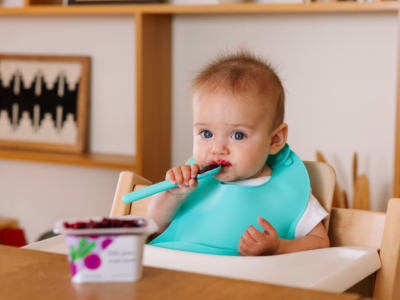I think most parents would agree that the process of potty training is not something we look forward to–but we do all want the end result of no more diapers, and we want it to come as quickly and easily as possible! That leaves us up late at night Googling “best potty training method” in hopes of finding that ultimate potty training miracle cure.
As a professional potty training consultant, I hate to burst your bubble, but unfortunately there is no one-size-fits-all potty training method that is guaranteed to work for every child. Every child is different and so will be their potty training journey–even between siblings! There are many factors to consider when preparing for this milestone including your child’s personality, their learning style, your family’s lifestyle, and more.
Generally speaking, potty training can be broken down into two simple approaches. There is the Parent-Directed approach in which the parent determines when to begin the process and takes the lead on the teaching. Then there is also the Child-Directed approach, which has become increasingly more common, where parents will wait for their child to “be ready” or initiate the process of potty learning on their own. Typically, the Child-Directed approach leads to an older potty training age average–somewhere between 32 and 38 months–and the Parent-Directed approach results in a younger age average. For most kids, a combination of these two approaches works best.
How do I know when to start potty training?
There are many signs of readiness your child may begin displaying:
- Staying dry for longer periods throughout the day
- Asking for their diaper to be changed
- Telling you before they go in their diaper
- Hiding to have a bowel movement
- Exhibiting a general interest in the bathroom
For those leaning toward a Parent-Directed approach, once the parent recognizes a few of these signs, they will initiate potty training. For those who think a Child-Directed approach is more their speed, then parents may take these signs of readiness a step further and in addition to them, wait for the child to start sitting on the potty themselves, or express not wanting to wear diapers anymore. Of course this is completely personal preference and there is no right or wrong answer. However, keep in mind that some kids will never exhibit any of the classic signs of readiness and it is perfectly okay for you to initiate the process as your child’s teacher and coach!
Once you’ve decided that you are going to start potty training, you will need to consider some other important factors. Before you begin, be sure that you have chosen a time in your family’s life that is as normal as possible…so maybe we’re waiting until 2021. This means don’t start potty training around the same time that your family or child is experiencing some sort of major change like moving, bringing home a new baby, going through a divorce, etc. Getting rid of diapers is enough for your little one to cope with!
Gradual potty training
When you have figured out a good time to start potty training, you will need to decide if you will introduce the potty gradually, or if you will dive in and eliminate diapers cold turkey with more of a bootcamp style, or 3-day method. Generally speaking, the Child-Directed approach leans more towards a gradual method of potty training because it will be paced by the child themselves. On the other hand, the 3-day/cold turkey methods lend themselves more towards a Parent-Directed approach. Remember to consider your child’s personality when choosing. If your child has any of the below traits, they will do best with a gradual introduction to the potty:
- Stubborn
- Resistant to change
- Relies on routine and schedules
- Independent
- Strives to maintain control over things
In this case, take some time to get your child familiar with the concept of potty training with no pressure for a couple weeks before you remove diapers which will help them feel more comfortable with the upcoming change. Some ways to do this would be by:
- Reading potty books
- Watching potty videos
- Performing standing diaper changes in the bathroom
- Playing pretend with toys and dolls using the potty
- Inviting them into the bathroom with you when you need to go
- Incorporating one or more scheduled potty sits throughout the day
- Counting down the days to no more diapers
As you notice your child becoming more comfortable and on board with the potty, then you can move to some diaper-free time to allow your child to become familiar with their body’s signals AND to experience some accidents! Accidents are actually great learning opportunities, and you can always try to turn an accident into a success by catching some pee or poop in the potty. This process will likely span a few weeks or more, but remember, potty training is not a race! So if it is what works best for your child, then run with it!
Cold turkey/Three-day potty training
Alternatively, potty boot camp, or 3-day methods are super popular and effective if your child’s personality tends to be:
- Laid back
- Adaptable
- Craving structure
- Needing clear boundaries
These methods tend to forego all the “potty prep” and ditch the diapers cold turkey over the course of a one to three day period. Typically, parents will remove all diapers (except for sleep) and either move right to underwear, or have a period of bottomless time. This means not leaving the house at all during the training period. Most of these methods involve setting a timer and having the child sit on the potty every 20 to 30 minutes whether they need to go or not to encourage practice and get them comfortable with sitting on the potty. Rewards may or may not be used. Try to keep in mind that these first few days are mainly just to lay the groundwork. Your child will likely not be fully trained within a weekend, and that is perfectly okay!
No matter what method you choose, it is important to keep in mind that potty training is a marathon, not a sprint. It isn’t something that can be rushed, and it takes hard work to maintain and advance progress beyond the initial training period. The best thing you can do is stay consistent and make sure all your child’s caregivers are on the same page to avoid any mixed messages. Also, don’t forget to have confidence–in both your child and yourself! As Theodore Roosevelt said, “Believe you can and you’re halfway there.”
Happy pottying! xo



